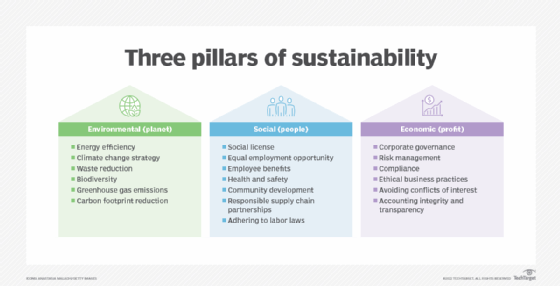
Getty Images
9 resolutions for businesses going green in 2023
Customers are concerned about the environment and may consider a company's impact. Using small steps, companies can improve their sustainability and lessen their carbon footprint.
Businesses can help lower operating costs and overhead expenses and increase their customer base by taking a few steps to go green.
Business sustainability is at the top of consumers' minds as they are more concerned about environmental and social impacts. Today, 66% of consumers say sustainability is one of the top factors they consider before making a purchase, according to a report from Simon-Kucher.
As you look to 2023, there are some steps you can take for your business to become more energy efficient. Green initiatives such as reducing energy consumption and reusing materials can help your business lessen its environmental effect.
Here are a few small steps to take that can make a big difference to help your business become more sustainable.
1. Implement a recycling program
Place recycling bins throughout the office, make them easily accessible and encourage employees to recycle as much as they can. Find out what is recyclable with your waste management service and make sure it is posted on the bin so employees know what they can recycle.
Along with recycling paper and plastic, don't forget about e-waste, which can lead to toxic chemicals leaking into the ground. Common e-waste items include computer parts, mobile phones, batteries and ink cartridges. Set up a collection for these items and look for recycling centers where you drop them off. For ink cartridges, several companies offer a mail-in return program to recycle and reuse.
2. Use alternative energy sources
You don't need to take large steps to get started using alternative energy sources. Solar, wind and geothermal energy sourcing are much easier on the environment than fossil fuels.
As vehicles need to be replaced in the fleet, switch to electric vehicles. And consider solar panels or wind turbines for power. This requires a large investment upfront; however, there are rebates and tax savings to help recover these costs.
3. Donate items
If your office is getting rid of any large materials -- such as a couch, desks or chairs -- check with local charities, churches or schools to see if you can donate them. Not only is it better for the environment, it also helps build rapport with the community. If you have leftover items with your company name on them such as pens, notebooks or shirts, it's free advertising.

4. Switch to environmentally friendly suppliers
Check with your vendors and suppliers to see if they focus on sustainability. If they do not, consider finding and supporting businesses that focus on their environmental impact. If possible, choose local companies to limit shipping and the carbon emissions that come with it. You want to be cautious of what vendors are associated with your business and align with other companies that focus on sustainability as well.
Also consider the raw materials used in products. See if there are any alternatives to harmful ingredients such as flame retardants, lead, mercury and certain phthalates.
And don't forget to consider how the goods are packaged. Look for suppliers that limit their plastic packaging to avoid additional waste.
5. Reduce energy use
By using less energy, you can save money and limit the effects on the environment. One way to save on energy is to address the phenomenon known as vampire power, which is when electronics continue using energy even in standby mode. Unplug devices and chargers when not in use. And turn off devices instead of letting them go to standby mode.
Another simple way to reduce energy usage is to replace standard lightbulbs with LEDs, which use up to 90% less energy than incandescent bulbs. LEDs can last up to 25 times longer, which means you will reduce energy use and buy bulbs less often.
Turning off lights in unused spaces also reduces energy use. You can also install motion sensors to automatically shut off lights when a room is empty.
6. Limit paper use
Despite the increase in digital communications, paper and paperboard account for nearly 23% of solid waste in landfills, according to the EPA. By reducing paper use, you can also save money by buying less paper and ink along with lessening your carbon footprint.
Encourage storing documents on the cloud, which is also a more secure method. Digital files are easier to secure than hard-copy paper files on desks or in filing cabinets.
If you need hard-copy documents, try printing on both sides. For marketing materials, have clients request the hard copy version of a document -- such as a catalog -- versus giving it to them immediately.
Learn more about the benefits and challenges of being a paperless office.
7. Decrease the use of throwaway items
One of the most significant ways a company can go green is to eliminate single-use products -- especially plastic. Replace everyday items with reusable alternatives such as offering real silverware in the office kitchen, coffee mugs and washable rags. These items require an investment upfront but will save money in the long run since they won't need to be replaced.
There may be a few additional steps such as washing dishes and towels, but if employees are on board, it can make a big difference. Get employees personalized coffee mugs and water bottles to encourage reusing materials.
8. Start a takeback program
A way to make sure your product doesn't make it into a landfill is to offer a takeback program, where the customer returns the item to you when they are done with it.
There are some financial incentives for companies because they can funnel raw materials into their manufacturing process, saving money and preventing damage to the environment from extracting raw materials.
Depending on your product, you have control over sustainable methods to reuse or recycle materials. To encourage participation, offer incentives to customers such as returning your old product to receive a percentage off your new product.
9. Get employees involved with 'go-green' initiatives
Get your employees on board and get their input on goals. Offer incentives for employee participation at work and at home. A small recognition on the company intranet or in a meeting can go a long way toward improving your company's environmental impact. Create visuals and goals showing employees the progress of your green initiatives.
Depending on your office location, you can offer initiatives for your employees' commute to work, such as encouraging employees to ride bikes or walk to work -- similar to Amazon's program.







